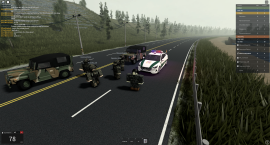Tabarka Naval Landings: Difference between revisions
No edit summary |
No edit summary |
||
| Line 29: | Line 29: | ||
|casualties1 = 30+ dead | |casualties1 = 30+ dead | ||
|totalcasualties = 40~ | |totalcasualties = 40~ | ||
}}The landing in Tabarka by the forces of the Kuril Republic and the Republic of Alexandria | * 3 from friendly fire | ||
}}The landing in Tabarka by the forces of the Kuril Republic and the Republic of Alexandria, marking a significant escalation in regional tensions and geopolitical manoeuvring. | |||
As dawn broke over the coastal city, the | ==Prelude== | ||
As dawn broke over the coastal city, amphibious vehicles from the Japanese and Alexandrian armies approached the Tunisian coastline of Tabarka, of the north western point of the country. Leading the charge were the soldiers of the Kuril Republic. Accompanying them were two Alexandrian jeeps, the objectives of which were to capture the city of the coast to ensure a logistical supply hub could be constructed. | |||
Accompanying them were two jeeps | ==The battle== | ||
As the vehicles moved into the city, heavy fighting broke out, initially the Tunisians failed to take defensive positions in a series of dissolution. Leading to the Japanese and Alexandrians initially seizing the school area. The Tunisians decided to fall back to the city outskirts to take a more defensive position. Simultaneously, other vital buildings fell under the control of the invading forces, particularly the garage area infront of the school. | |||
==The seize of the city== | |||
As the battle continued into the final portions, Tunisian forces were completely decreased to around 2 soldiers against the larger invading force of around 6-7, the Tunisians took lowland defensive positions in civilian areas however were picked off by Japanese snipers and assault troops. | |||
Simultaneously, other vital buildings fell under the control of the invading forces, | ==Aftermath== | ||
The battle resulted in a decisive, only around 4-8 invading forces were killed of which around 3 were from friendly fire, the invading forces were able to successfully secure the city and establish a coastal beach head west of the capital of Tunis. Additionally, the Tunisian forces retreated to the western bits as to defend the capital. | |||
The | |||
[[Category: Battles]] | [[Category: Battles]] | ||
Revision as of 11:26, 20 April 2024
| |||||||||||||||||||||||||||||||||||||||||||||||||||||||||||||||||||
The landing in Tabarka by the forces of the Kuril Republic and the Republic of Alexandria, marking a significant escalation in regional tensions and geopolitical manoeuvring.
Prelude
As dawn broke over the coastal city, amphibious vehicles from the Japanese and Alexandrian armies approached the Tunisian coastline of Tabarka, of the north western point of the country. Leading the charge were the soldiers of the Kuril Republic. Accompanying them were two Alexandrian jeeps, the objectives of which were to capture the city of the coast to ensure a logistical supply hub could be constructed.
The battle
As the vehicles moved into the city, heavy fighting broke out, initially the Tunisians failed to take defensive positions in a series of dissolution. Leading to the Japanese and Alexandrians initially seizing the school area. The Tunisians decided to fall back to the city outskirts to take a more defensive position. Simultaneously, other vital buildings fell under the control of the invading forces, particularly the garage area infront of the school.
The seize of the city
As the battle continued into the final portions, Tunisian forces were completely decreased to around 2 soldiers against the larger invading force of around 6-7, the Tunisians took lowland defensive positions in civilian areas however were picked off by Japanese snipers and assault troops.
Aftermath
The battle resulted in a decisive, only around 4-8 invading forces were killed of which around 3 were from friendly fire, the invading forces were able to successfully secure the city and establish a coastal beach head west of the capital of Tunis. Additionally, the Tunisian forces retreated to the western bits as to defend the capital.
- ↑ 3 active, shortened to 1 for most of the battle
